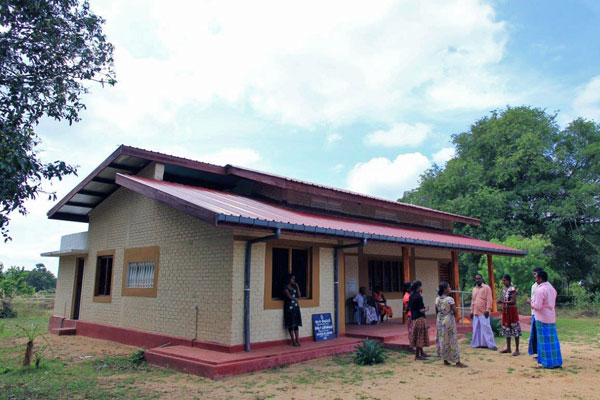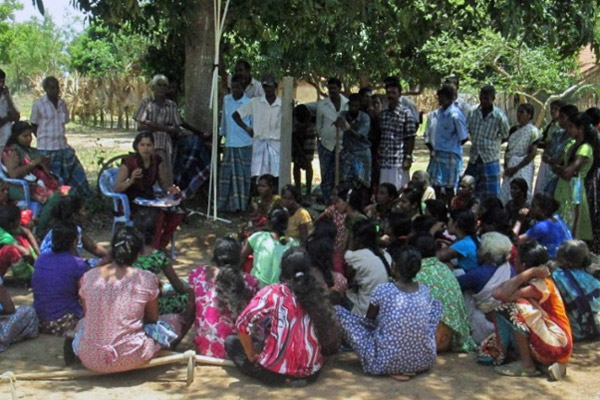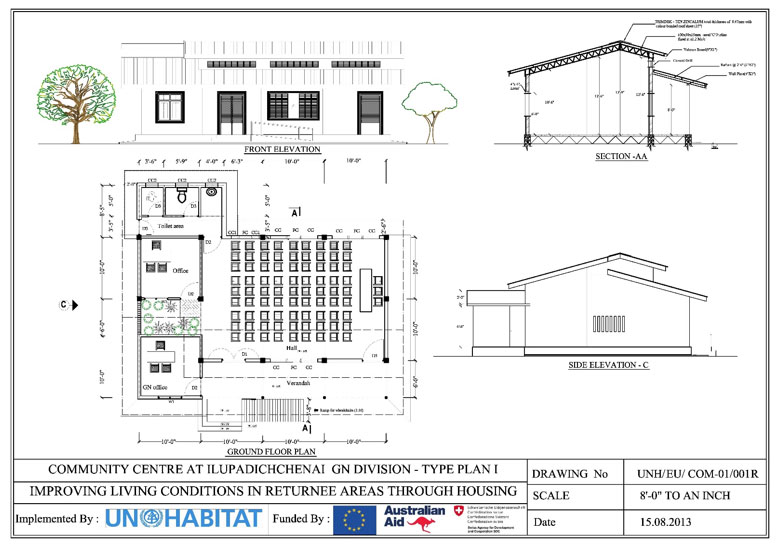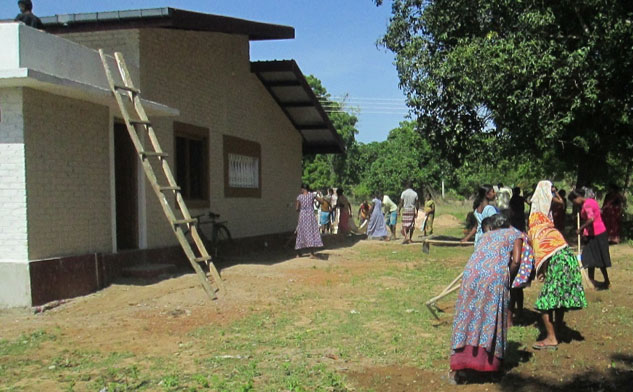Stories from the Field: New Community Centre for Illupadichchenai Residents in Batticaloa District

Illupadichchenai Community Centre, Batticaloa district.
Community centres are an important element of village life in Sri Lanka. They are used for events, village level administration, to disseminate public information and to conduct public meetings and regular health clinics for residents. The lack of such an indoor space in a village can cause serious inconveniences to communities. In 2014, with funding from the Improving Living Conditions in Returnee Areas of Sri Lanka through Housing Project, a new community centre was constructed through a participatory process in the Grama Niladhari (GN) division of Illupadichchenai in Batticaloa district.
This Project is a housing recovery initiative providing support to returning internally displaced persons in the North and East of Sri Lanka. Funded primarily by the European Union, donor partners include the Government of Australia and the Swiss Agency for Development and Cooperation (SDC). Jointly implemented by UN‐Habitat and SDC, the project provides cash grants and technical support to homeowners to reconstruct and repair their conflict damaged houses. In addition to housing, the project is also supporting the construction of essential community infrastructure facilities including community centres, internal access roads, preschools and wells to support resettled families to resume normal life in their villages.

Community meetings were held outdoors as the village lacked a common building.
Illupadichchenai GN division, consisting of four villages, is located in the Manmunai West DS Division of Batticaloa district. The protracted conflict had caused significant damage and destruction to the village, affecting the lives of over 1,300 people who had faced displacements and hardships. This GN division is particularly vulnerable as it has 74 female headed households. The village infrastructure including housing and community assets such as schools, wells, roads and community buildings were damaged due to the conflict. Agriculture is the main livelihood for the majority of residents followed by livestock farming and daily wage labour. As this village had no resources to build their own community centre, meetings and events were held outdoors, most often under a tree.
A Settlement Improvement Planning workshop was conducted by UN-Habitat to identify the main issues affecting the community. During the workshop, the residents identified the construction of a community centre as a priority need. This initiative was selected for funding by the project in October 2013. As the project follows a participatory process of reconstruction, the construction of the community centre was contracted to a local community based organisation, the Illupadichchenai Rural Development Society (RDS), following a rigorous selection process in collaboration with the local Government Authorities. The land to build the community centre was generously donated by Mr. Vanniyasingham, one of the senior residents of the village. Three type plans for the community centre were shared with the community at a public meeting, and the design with a floor area of 1,120 Square feet was selected by the community (see below).

Design type plan of the community center.
The construction of the community centre commenced in December 2013, with a total grant of LKR. 2.5 Mn provided in several instalments to the RDS based on the physical progress of work. The RDS hired skilled construction workers and purchased building materials in consultation with UN-Habitat. Technical assistance on all construction activities including the preparation of the bill of quantities and quality monitoring was provided by UN-Habitat, along with special training on sustainable construction and disaster risk reduction methods for the RDS and artisans.
The implementation of the project was driven by the community, giving them ownership of this public asset from the outset. The Divisional Secretary of Manmunai West assisted the community to regularize the land ownership while the Rural Development Officer (RDO) worked closely with UN-Habitat, from the selection of CBOs to monitoring the progress and financial records. The Grama Niladhari also monitored the progress and supported the RDS to expedite construction while assisting UN-Habitat to organize regular progress review meetings. Mr. Arasakumar, the RDO, discussing the implementation process stated: “A key feature of this project was that the community members were at the centre of the decision making process. They collectively solved issues related to construction and ensured participation from different groups. The CBOs in the area have gained skills in managing construction related projects, which has encouraged these organisations to be more active.”

Residents engaged in cleaning the community centre grounds.
The community centre was completed in September 2014 and is now regularly used by the residents and Government officials for events and village administration. The building consists of a large hall, two office rooms for Government officials, toilets, and a verandah which is used as a reception area. A rainwater harvesting system has been installed on top of the toilet unit to collect and reuse water. The secretary of the Ilupadichchenai RDS, Mr. S. Yoganathan, stated “The opportunity to manage this project has given our members new skills and valuable experience. By working cohesively, we have created important bonds with community members.”
“In addition to housing support, the donors have assisted our village to build this new community building. This community centre is now used for gatherings and events of the four villages in Illupadichchenai GND” Mr. K. Varatharaja, the Grama Niladhari Officer of Illupadichchenai stated.
The “Improving Living Conditions in Returnee Areas of Sri Lanka through Housing” Project is being implemented from January 2013 to June 2015 in the districts of Killinochchi, Mullaitivu and Mannar in the North and Batticaloa in the East. The project will support the reconstruction of 4,600 houses and a number of infrastructure initiatives including 12 preschools, 14 community centres, 17 wells, and the rehabilitation of approximately 38 km of internal access roads.
